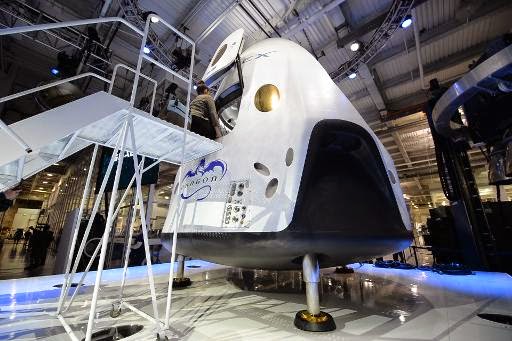Dragon cargo ship on its way to the International Space Station.
A
Space Exploration Technologies Falcon 9 rocket blasted off from Cape Canaveral Air Force tion.
The rocket lifted off at 4:47 a.m. EST (0947 GMT), streaking through nighttime skies as it headed into orbit.
Nine minutes later, the rocket’s upper-stage engine shut down and deposited Dragon into its preliminary orbit.
The capsule was due to reach the space station, which circles about 260 miles above the planet, on Monday.
As Dragon began its solo journey, the discarded first-stage booster was attempting to land itself vertically on a platform in the ocean, part of an ongoing series of tests to develop reusable rockets.
"Rocket made it to drone spaceport ship, but landed hard," SpaceX founder and chief executive Elon Musk posted on Twitter.
The rocket was aiming for a 300- by 100-ft platform stationed about 200 miles off the coast of Jacksonville, Florida, in the Atlantic Ocean.
Ground control teams reported two engine restarts as the rocket descended back through the atmosphere before the communications link was lost.
The rocket was expected to make one more engine burn and extend four landing legs prior to touchdown.
SpaceX engineers stationed on a nearby support ship tried to catch the descent and landing on video, but it was "pitch dark and foggy," Musk said. "Didn't get good landing/impact video ... Will piece it together from telemetry and ... actual pieces."
The ship itself is fine, he added, though some of the support equipment on the deck will need to be replaced, Musk added.
He previously had pegged the chance of a successful touchdown on the first try at 50 per cent.
"Returning anything from space is a challenge, but returning a Falcon 9 first stage for a precision landing presents a number of additional hurdles," SpaceX said in a blog post about the test.
"At 14 stories tall and traveling upwards of 1300 m/s (meters per second), stabilizing the Falcon 9 first stage for re-entry is like trying to balance a rubber broomstick on your hand in the middle of a wind storm."
SpaceX Launch. Credit: M. Staples
To help stabilise the stage and to reduce its speed, SpaceX relights the engines for a series of three burns.
The first burn, the boostback burn, adjusts the impact point of the vehicle and is followed by the supersonic retro propulsion burn that, along with the drag of the atmosphere, slows the vehicle's speed from 1300 m/s to about 250 m/s.
"The final burn is the landing burn, during which the legs deploy and the vehicle's speed is further reduced to around 2 m/s.
“The legspan of the Falcon 9 first stage is about 70 ft and while the ship is equipped with powerful thrusters to help it stay in place, it is not actually anchored, so finding the bullseye becomes particularly tricky,” SpaceX said.
“During previous attempts, we could only expect a landing accuracy of within 10 km. For this attempt, we’re targeting a landing accuracy of within 10 meters,” SpaceX said.
SpaceX Falcon 9 rocket grid fins. Credit: SpaceX
Musk said dark and foggy conditions prevented cameras aboard the rocket and the landing barge from recording good video of the impact, but there is plenty of other data to help determine what happened.
SpaceX engineers revealed that a loss of power in the grid fins caused a loss of control of the launcher, resulting in it being damaged on impact.
Musk tweeted the grid fins added to the rocket launched Saturday “worked extremely well from hypersonic velocity to subsonic, but ran out of hydraulic fluid right before landing.”
An upcoming flight will carry 50 percent more hydraulic fluid, Musk said. The mission “should have plenty of margin for landing attempt next month.”





















































